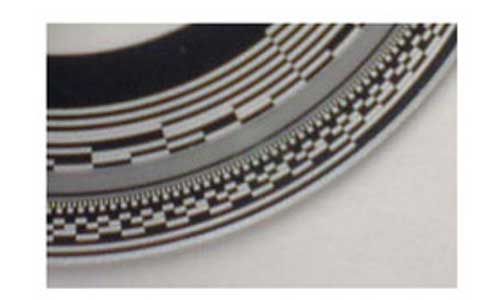Absolute Encoder (Working Principle, Types, Applications, Advantages)
A rotary encoder is required to measure the speed, direction of motion, or position of a rotating shaft. There are 2 main types of rotary encoders to choose from; the incremental encoder and the absolute encoder. Since choosing the right rotary encoder is important, this text is a short guide about one of the types of rotary encoders namely absolute rotary encoders to help you obtain information about what they are, how they differ from incremental encoders, as well as their application and advantages.
What is an Absolute Encoder?
Absolute encoders are feedback devices that provide information about the absolute position or true angular position of the encoder.
When the rotary encoder is switched on, it gives the exact position of the rotating shaft that it is measuring.
This encoder generates unique w
ords or bits for each shaft position and every position is distinctive but an incremental encoder generates a continuous stream of ubiquitous pulses.

Since each word or code is a unique reference and each position is distinctive, therefore after switching the encoder on, there is no need for a reference that increases the safety and efficiency of machines and systems.
In other words, when the power is lost, and a movement is made in this situation, this position is retained instantly when the power is reapplied and the encoder knows its true new position.
Types of Absolute Encoders
Based on the sensing technology, There is 2 configuration for absolute rotary encoders:
Optical configurations, which provide the highest possible resolution and accuracy, and Magnetic versions, with maximum robustness and lifetime that can be used for demanding environments.
And also absolute encoders are in 2 different forms, single-turn or multi-turn.
Single-turn encoders: This type of encoder is a preferred choice for short travel motion control applications where position verification is required within a single turn of the encoder shaft.
Multi-turn encoders: These encoders are better for use in applications that require complex or lengthy positioning and provide additional feedback for the number of 360-degree turns.
Working Principle of Absolute Encoder
Depending on the design type of optical or magnetic, the method of the absolute encoder is slightly different, but the working principle is the same.
As said before, absolute encoders generate a digital word of the bit as the shaft rotates.
They have an LED array, optical disk, and photo sensors.
There are two discs, both with concentric tracks and different patterns. A code disc attached to the central shaft and a fixed mask or stationary mask that allows the system to create a unique binary code for each point of position.
As the code disc turns atop the fixed mask, the system periodically reads out the code and generates it as a multi-bit digital word. These binary codes within the absolute rotary encoder represent the absolute position.
The resolution of absolute encoders is described as the number of bits in its output word. The output word can be in natural binary or in gray code, which creates only a single bit change at each step to decrease errors.
Absolute Encoder vs. Incremental Encoder
| Absolute | Incremental |
| High cost and more complex compared to incremental type | Simple and inexpensive |
| When the power is switched off, the information of position is saved. | When the power is switched off, the system shows an error and needs a reference point. |
| For use in different applications such as diagnostic imaging, surgical robotics, etc., where controlling, monitoring is required |
An ideal solution for use in applications where velocity and direction information is required |
| It outputs a unique code for every shaft position to represent the absolute position of the encoder. | It is used to report changes in the angular position of the shaft and generates a continuous stream of pulses or digital signals. |
| Need power while using this device | Need power throughout the operation |
Where are Absolute Encoders used/Applications?
Absolute encoders are the right choice in a versatile and wide range of applications where controlling or monitoring mechanical systems is required. These applications include;
- Surgical robotics
- Microelectronics
- Diagnostic imaging
- Oil and Gas
- Home-assistance robots
- Photonics
- Medical Equipment
- Radiation therapy
- Renewable Energy
- Industrial robotics
- Satellite communications
- ROVs & UAVs
- Industrial Valves
- Water Wastewater
- Factory Automation
- Mobile Machines
- Determining the multi-axis direction for CNC machines used in the production of parts
- Automatic determination of the height of scissor beds used in hospitals
- Accurate positioning of several stabilizers for large vehicles such as cranes and airlifts
- Door movement or automatic positions without limiting keys
Advantages and Features
- High immunity to electrical noise
- Compact design
- Non-volatility of memory or reliable and accurate position feedback without referencing
- Higher-resolution compared to incremental encoders
- Better start-up performance due to low humming time (or initial position)
- Accurate motion detection along multiple axes
- Several output protocols for better integration of electronic components
- Flexible programming
- Supporting all relevant controllers and different interfaces including: SSI, BiSS, all relevant Fieldbus and real-time Ethernet interfaces and high-quality incremental signals
Still curious? Click on the below links to know more:
Guess the Dominating Brand in Middle East for Rotary Encoder
Encoder Resolution, Encoder Accuracy, and System Repeatability
Linear Encoder (Types, Applications, Advantages)
Recent Posts
-
Booster Pump Troubleshooting and Maintenance: How to Fix and Prevent Common Issues
1. Introduction Imagine turning on your faucet only to be greeted with a weak trickle of water when …22nd Apr 2025 -
Energy-Efficient Booster Pumps: Selection and Tips for Maximizing Performance
1. Introduction Imagine never having to deal with fluctuating water pressure, noisy pumps, or skyroc …19th Apr 2025 -
Booster Pumps for Sustainable Water Systems: Irrigation and Rainwater Harvesting Solutions
1. Introduction Water scarcity is no longer a distant threat—it’s a reality affecti …16th Apr 2025




